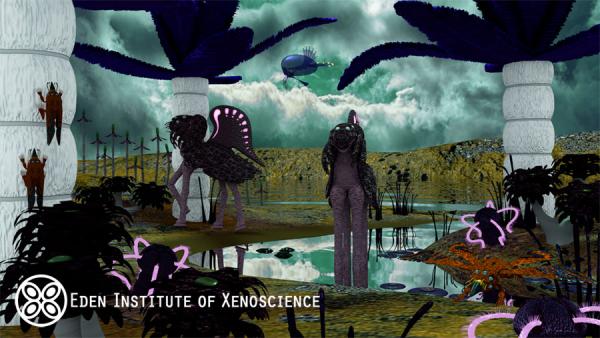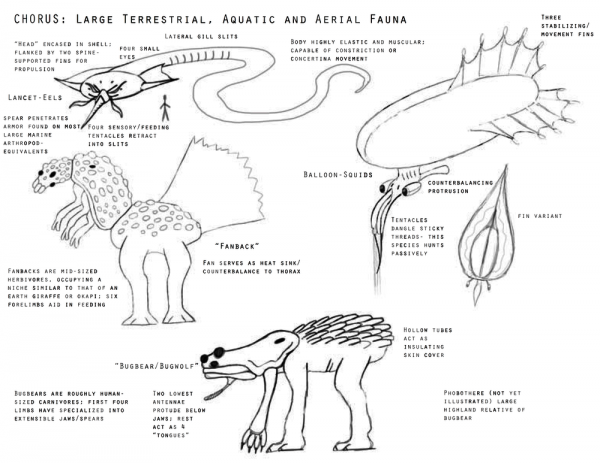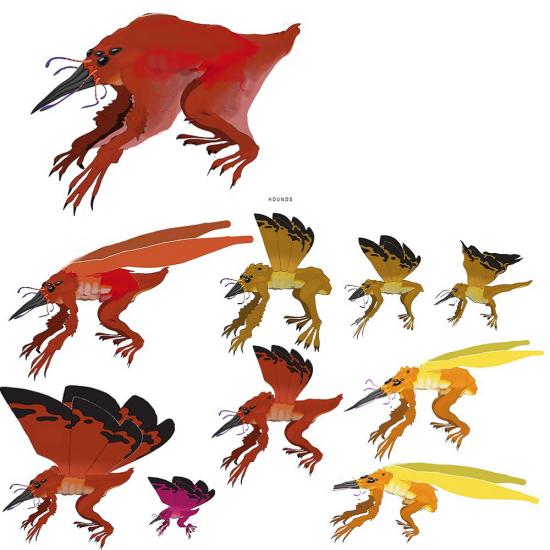BY LETTER
Chorus - Xenobiology
Animal and plant life on the Jade Chime Singer homeworld | |
 Image from Andrew P. | |
| Lifeforms in the chlorine-rich biosphere of Chorus | |
Chorus, the homeworld of the Jade Chime Singers is an example of the relatively rare Chlorine world type with a complex biosphere comparable to Old Earth before the Holocene extinction. On land, the dominant biomes are swamp and rainforest. There are extensive tidal flats, and the equivalent of reed beds, eelgrass meadows, and mangrove swamps, along most shores. The intertidal zone is extraordinarily broad, extending for kilometres, because of the large tidal range of the oceans and the shallow slope of most coastal plains. Forests do not reach great heights. Gravity restricts more conventional tree-like forms to heights of 25 metres or less. In areas sufficiently sheltered from storms, the bladderforests, supported by buoyant gases, can reach heights of up to 75 metres, but this seems to be the maximum height to which the local vegetation can pump water from the ground. Though there are no true deserts, there are hundreds of square kilometres of sand dunes along some of the drier coastlines. The high rainfall leads to many river, lake, and estuarine habitats. There are extensive reefs in the shallowest waters; ranging from massive barrier reefs to the atolls that ring the eroded remains of island volcanoes. Further out there are seaweed forests, and the deeper waters have extensive "sargasso" habitats of floating vegetation. Airborne life of all kinds is rich in small flying arthropods and larger dirigible-like forms. The balloon-squids can be several metres in length, but large winged life forms that move without flotation devices are relatively rare, perhaps due to competition with the "balloon-squids". The most numerous actively flying species are the flitterhounds, bird- or bat-analogs that take many forms.
 Image from Andrew P. | |
| Several common animal-like lifeforms on Chorus | |
The plant life forms cloud-forests of floating vegetation where there is sufficient rainfall; these forests have their own unique, if somewhat restricted, ecology. Upland forests also have a distinct ecology, adapted to the relatively thin air and lower concentrations of chlorine; they are dominated by the local "lichentrees" (advanced symbiotic organisms composed of Chorus' equivalents of fungal and algal organisms).
The numerous and geologically short-lived volcanic islands, the many lakes, and the small sizes of the continents, have encouraged an extraordinary degree of speciation. In addition, it appears that unlike some other Gardenworlds Chorus has experienced relatively few major extinction events, and the number of fundamentally distinct life forms is therefore relatively high. The number of species catalogued so far exceeds 4 million and is expected to be an order of magnitude higher when the oceanic and microscopic species surveys are complete. There are 35 distinct phyla of animal-like life, 10 land-based plant-like phyla, 7 phyla of fungal equivalents, and 4 phyla of multicellular algae in addition to many microscopic forms.
Among the animals, the number of amphibious species is extremely large, partly because of the large areas of swamps and tidal flats. The corresponding number of phyla that have adapted to land is also significant: no fewer than 8 animal phyla have extensive populations on the land and in the air.
The dominant phylum of large terrestrial animals has an internal skeleton, breathes air through a pair of trachea (though most forms also have a set of gills on the underbody), and is decapodal. There are four pairs of mouthparts (derived from ancestral limbs) and three pairs of eyes. The eyes are on the model of Old Earth jumping spiders rather than on those of Old Earth molluscs or vertebrates: there is no pupil and the lens is fixed. Changes in focus, and in the objects that fill the visual field, are achieved instead by moving the retina internally. Adjustment to light levels is achieved not by a pupil but by a photoreactive cornea. This can make it difficult at first for Terragen bionts to tell which direction one of these animals is looking, though of course locals can learn a great deal by watching for changes in the reflectivity and colour of the eye caused by shifts in the retina. In most forms the number of walking limbs is reduced to 4 or 6, and the remainder are either reduced or lost or are specialized.
Some predators in this group have an impressive set of grasping, rending, slicing and piercing limbs, while herbivores often have specialized appendages for plucking or nipping fruits and vegetation, or for pulling down branches. Many animals in this phylum, including the ancestors of the Jade Chime Singers, have limbs adapted to the creation of tools or dwellings: primitive weaving of nests or nets, construction of canals or huts, masonry, and spear or rock throwing are extremely common strategies. The most successful members of the phylum, including the members of the Jade Chime Singers, are descended from a small group of upland omnivores and have a highly active endothermic metabolism. They fill most of the large-animal niches both on land and the shallow seas, and are in some ways comparable to Old Earth mammals or archosaurs. For most, maintaining body temperature is a matter of radiating excess heat. Aquatic and amphibious forms use their gills for this purpose even if they do not require them for oxygen uptake, and the purely terrestrial forms have horns, or dorsal fins for heat dissipation. A few upland and polar forms require insulation, and have a feather-like body covering.
The other terrestrial animal-like phyla include arthropod analogs, an extensive snail-like phylum, various earthworm-like analogs, and a sessile pentaradial filter-feeding form which is comparable to a land-dwelling crinoid. These last, since they can also photosynthesize, are sometimes mistaken for a sort of carnivorous plant. Large patches of the more venomous varieties are a hazard to local life; the largest individuals are a hazard to any being. The mollusc-equivalents have an order of dirigible-like forms, rather like floating octopi or squids. These maintain buoyancy with hydrogen sacks, move about with a rippling wing/fin, and manipulate their food with a set of 10 to 25 tentacles. Of the numerous aquatic animal phyla, the most notable are some reef-building organisms comparable to corals, sponges, and clams, some manta-like filter-feeding invertebrates, a range of arthropod-like forms (filling the niche occupied by fishes on Old Earth) and some extremely large worm-like predators, the well-named lancet-eels. The larger and more active animals all use a respiratory pigment that requires chromium; their blood is bright orange when oxygenated or pale yellow when deoxygenated.
The fungal equivalents are numerous, and include many life forms superficially similar to mushrooms and encrusting molds. There is a related set of slime-mold like organisms, some of which achieve considerable complexity in their motile forms, and fill the roles that flatworms or slugs do in Terragen ecologies. There is also a very successful group of lichen-like symbiotes. These have achieved a high degree of specialization, and are comparable in complexity and sophistication to some of the most advanced plant life on other worlds. They produce compound seed/spores, and a flower-like organ is pollinated by small arthropod equivalents. Most are epiphytes or early colonists of the numerous lava flows, but they also grow in forests of squat needle-leaved "trees" in the uplands, where they are the dominant form of vegetation.
Like the photosynthetic forms on all other Chlorine Worlds, Chorus' plants are black (purple-black under terragen-style illumination). Foliage usually turns green and then yellow or red before it falls. Most vegetation consists of sprawling vines or bushes, or thickets of bamboo or reed like vegetation, or more rarely of stubby powerfully built trees. The tallest forests consist of plants that use bladders of lighter gases (usually methane or hydrogen) rather than growing thick support structures. These are usually somewhat like Old Earth kelp in profile, with rope-like stems upheld by bags of gases, though their leaves are rather like those of more typical land plants. Many plants have leathery or waxy leaves for protection against rains that are too acidic or alkaline. In the lakes and rivers a lily pad or lotus like form is extremely common, as are various kinds of floating vegetation. Leaves are usually broad and waxy, or grow in the form of fern-like fronds. In many cases the leaves fold up or the bladders deflate in stormy weather to prevent damage to the plant.
The equivalents of flowering plants are dominant even in aquatic environments. Many produce flower-like organs to attract pollinators. Flowers and fruit may be of any colour. Green is the most common. Some are blue (they look white or black to the Jade Chime Singers), and some are brown or black (but are bright in the far-red visible to many life forms on Chorus). Powerful scents to attract pollinators or seed distributors are quite common.
Bioluminescence is found in many plant, fungal, and animal forms, especially as a signalling device. Many night-blooming flowers use both scent and light. The colours are for the most part soft yellows and pinks.
The equivalents of shell, bone, and wood are various chlorocarbon polymers, often reinforced with graphite filaments, silica, silicate/carbonate minerals comparable to scapolite, and various acid-resistant metals and minerals (some organisms employ a thin coating of gold foil, for instance). Extensive reefs of these substances are known, and sands consist of these plus silica.
Upland areas are largely abandoned to their unique local life forms; the Jade Chime Singers cannot visit without technical support, and seldom go there unless they are scientists. There is a class of large local predator, in the uplands, the phobothere, that makes visits by unarmed individuals of any species a hazardous activity.
 Image from Arik | |
| The diverse environmental conditions on Chorus have resulted in considerable diversity within the Jade Chiime Singers themselves | |
Related Articles
Appears in Topics
Development Notes
Text by Stephen Inniss
; some additions by Andrew P.
Initially published on 23 September 2014.
; some additions by Andrew P.
Initially published on 23 September 2014.







